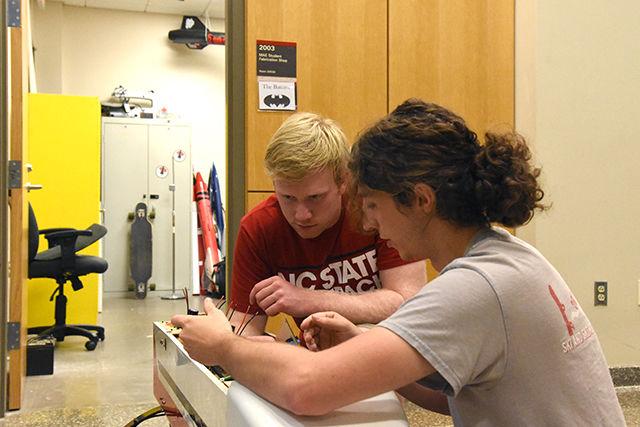Friday nights at the Aerial Robotics Club meetings on Centennial Campus start in a large room as members of the club share updates and reports on the progress of the central focus of the club, the plane. From there the meeting moves to their workshop, a small space subtly labeled “the Batcave.” The workshop shares a large window with the lobby of Engineering Building III. From the lobby, there is a clear view into the crowded and cluttered lab. Hanging from the ceiling are various models and planes as well as rockets from the rocketry club that shares the space. The tables and shelves in the lab are filled with technical parts and equipment and large mechanical tools take up the center of the room.
The ARC is one of many robotics clubs that helps to develop and capitalize on the technical skills of NC State students. According to Michael Aspden, a sophomore in aerospace engineering and the communications director for ARC, the club started in 1999.
The club competes in an international competition yearly at the beginning of the summer. Aspden says the competition includes fully autonomous takeoff and waypoint course as well as targeted water bottle drops and camera tracking. According to Aspden, the club works on the plane throughout year to prepare for the competition.
“One thing that I’ve always loved about ARC is just how open it is to people with no experience,” Aspden said.
This seems to be a focus in the club. Aspden explains how the club accepts all sorts of majors and all experience levels.
“I came here last year having no idea what I was doing,” Aspden said. “You learn from the different people here, and everyone is open to teaching you new things.”
Aspden also talks about the value of this learning experience, explaining the various technical skills that the ARC teaches.
The ARC involves a wide range of disciplines. Aspden explains the various subgroups that work on the plane, including the airframe group, which works with the physical plane body and focuses on the physics and design of the plane, the electric subgroup, which makes sure the various systems on the plane are powered and working, and the autopilot team, which uses computer science skills to automate the plane’s functions.
The focus on learning is shared by the Combat Robotics Club, a younger robotics club on campus that was founded early this September. Matthew Tompkins, a senior studying mechanical engineering, touched on this when asked about the skills learned in the CRC.
“Club members learn to use and become very competent in everything from SolidWorks [a design software] and machining to business planning and outreach,” Tompkins said. “The CRC similarly competes in competitions involving building a robot to incapacitate or remove another robot from the fighting ring.”
Apart from the regular process of designing and building the robots, the CRC shows a devotion to education in their plans to attend science, technology, engineering and math (STEM) nights at schools and talk to high school robotics teams, Tompkins says.
The passion for learning and the focus on creating a teaching environment is clear when attending one of the robotics club meetings. At the ARC meeting, the small lab was full of people working on various projects. Listening in it was clear that each group had people of varying levels of experience. The older, more experienced students allowed the younger students to work on various tasks and helped them to understand what was being done.
Part of what makes the robotics club such a valuable learning experience is the devotion and interest of the members in the club.
“My favorite part is watching something you designed, machined and built compete with builders and universities from all over the country,” Tompkins said.
Contemplating their best options, Michael Aspden, a sophomore studying aerospace engineering, and Justin Easter, a senior studying computer engineering, discuss whether they should remove solder or not in one of the parts of their latest aircraft on Sept. 30. The Aerial Robotics Club meets every Friday in the lobby of Engineering Building III at 6 p.m. The team hopes to win the competition this coming June.









